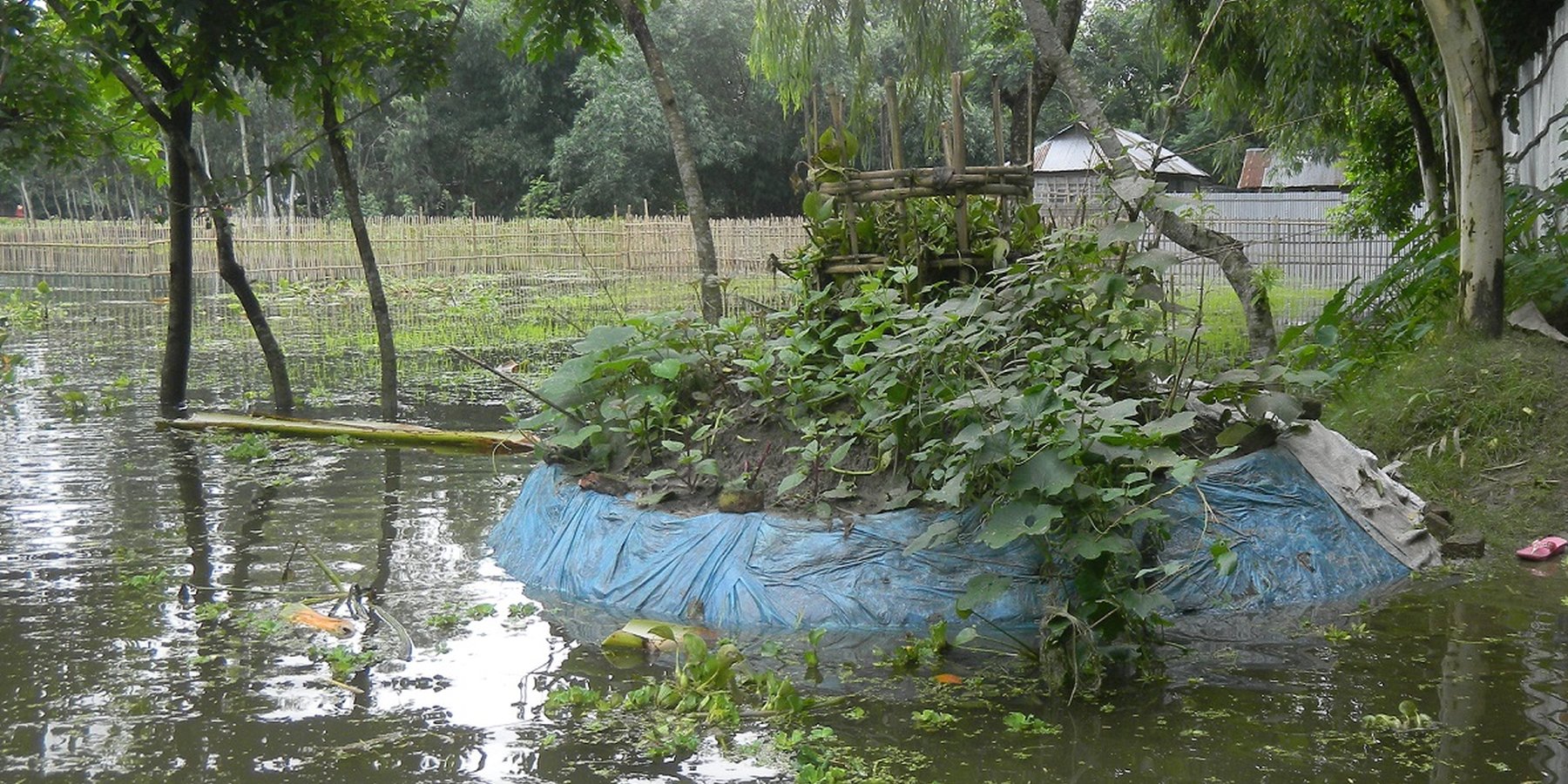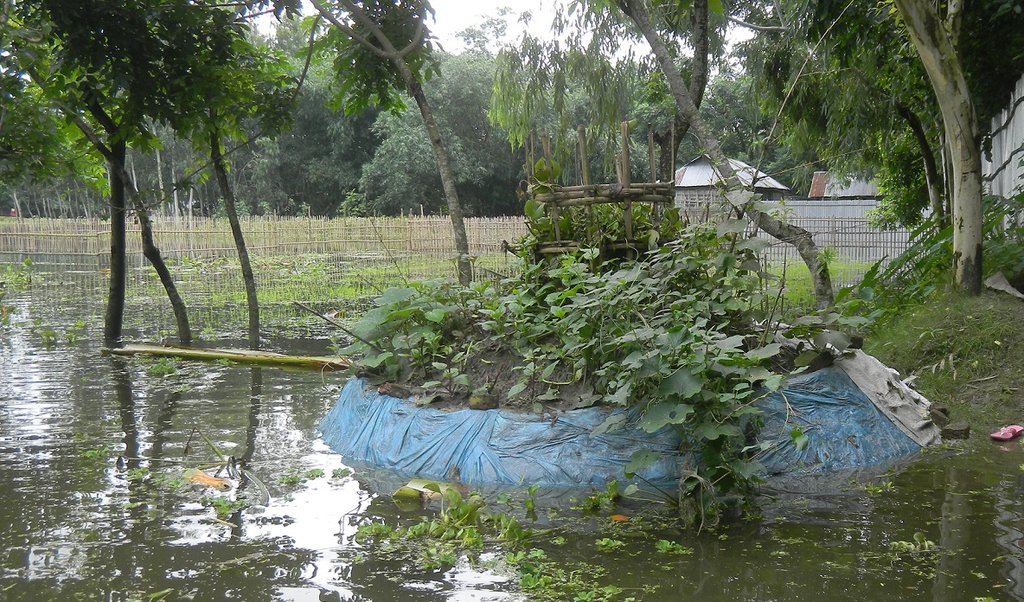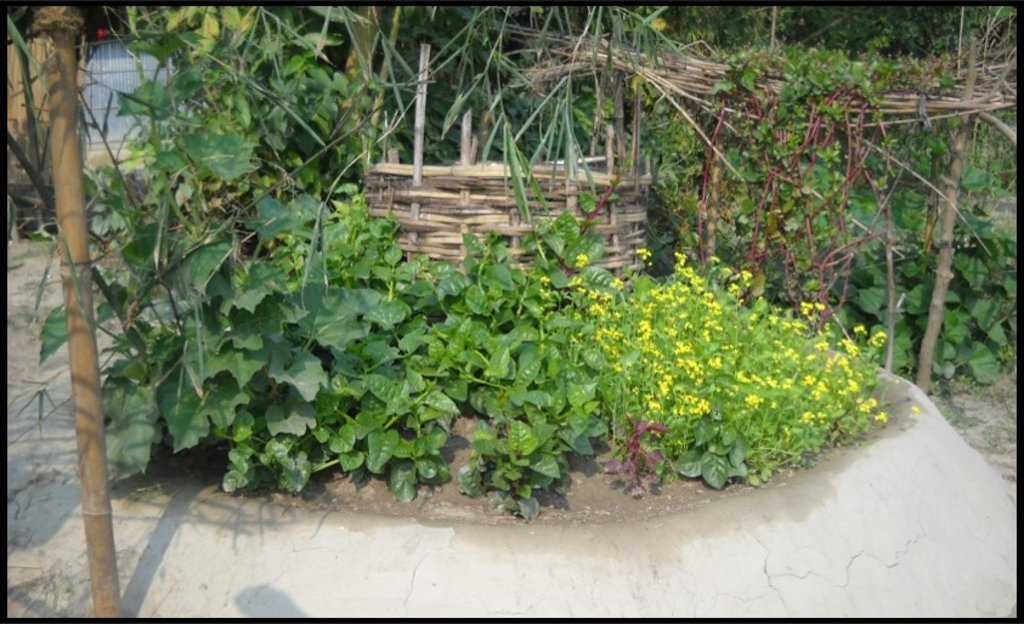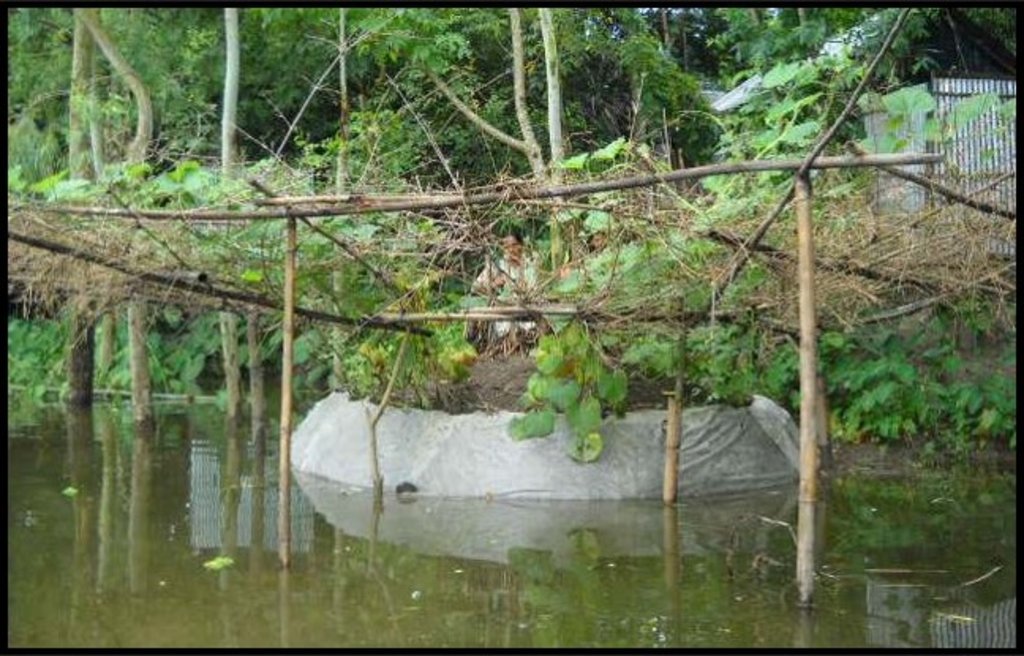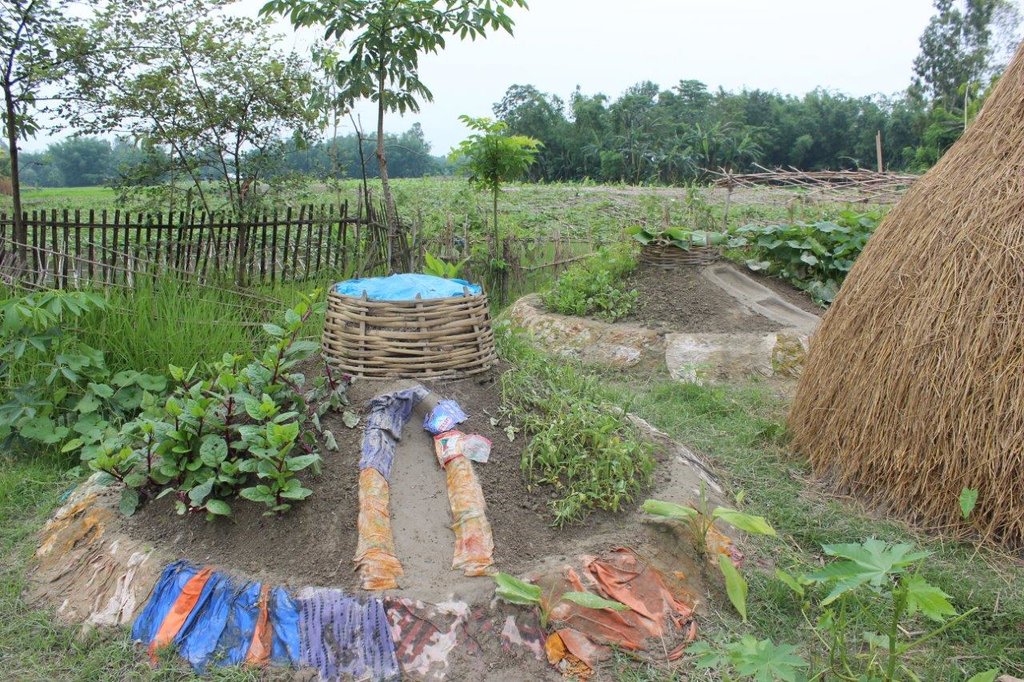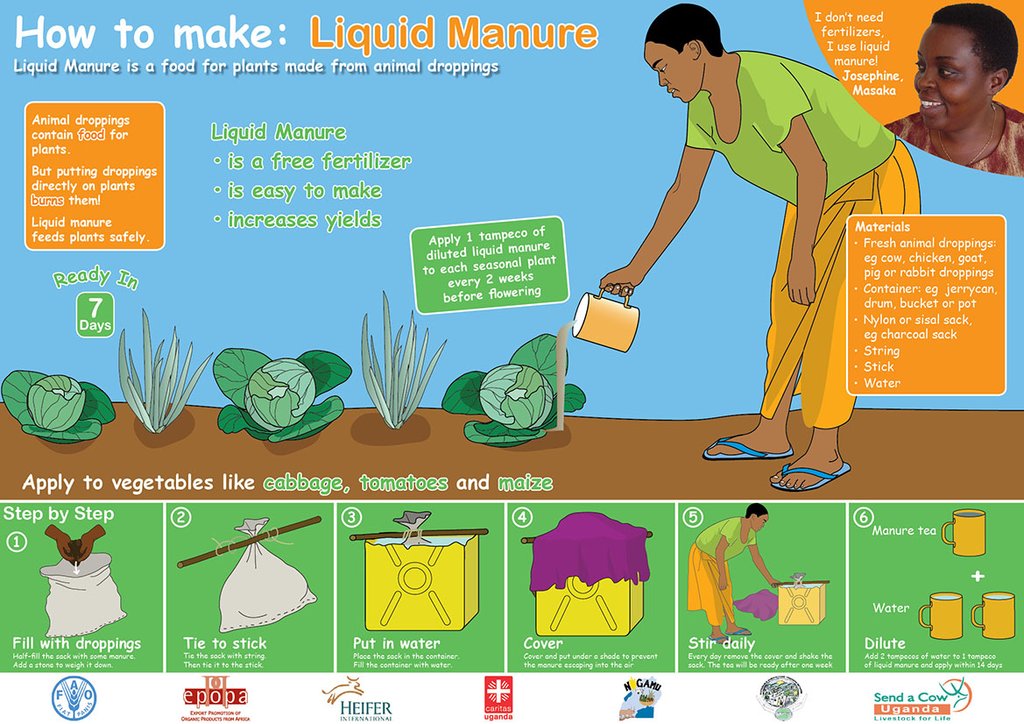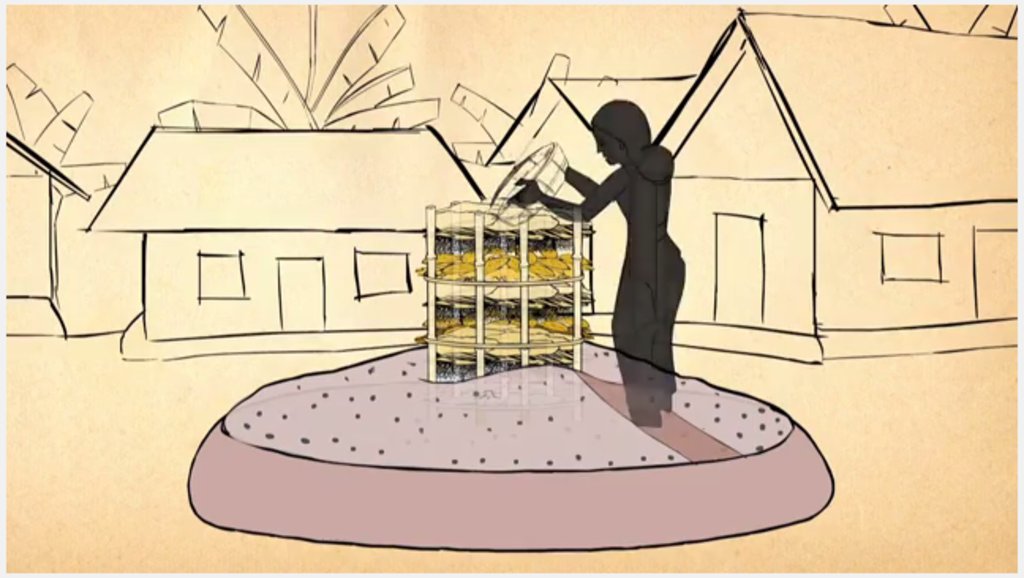Keyhole Garden [孟加拉国]
- 创建:
- 更新:
- 编制者: John Brogan
- 编辑者: Shahid Kamal
- 审查者: Alexandra Gavilano, Deborah Niggli, Alvin Chandra, Joana Eichenberger
PUSTI BAGAN ("Garden for nutrition")
technologies_779 - 孟加拉国
查看章节
全部展开 全部收起1. 一般信息
1.2 参与该技术评估和文件编制的资源人员和机构的联系方式
SLM专业人员:
Varadi Daniel
Greendots
瑞士
SLM专业人员:
Taylor Sheila
Send a Cow UK & Greendots
WASH Advisor:
有助于对技术进行记录/评估的项目名称(如相关)
Book project: where people and their land are safer - A Compendium of Good Practices in Disaster Risk Reduction (DRR) (where people and their land are safer)有助于对技术进行记录/评估的机构名称(如相关)
Terre des Hommes (Terre des Hommes) - 瑞士1.3 关于使用通过WOCAT记录的数据的条件
编制者和关键资源人员接受有关使用通过WOCAT记录数据的条件。:
是
1.4 所述技术的可持续性声明
这里所描述的技术在土地退化方面是否存在问题,导致无法被认为是一种可持续的土地管理技术?:
否
1.5 参考关于SLM方法(使用WOCAT记录的SLM方法)的调查问卷
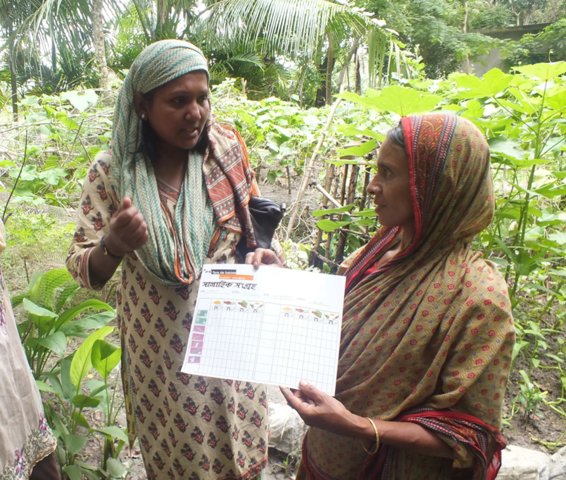
Peer to Peer Pass-on Approach with Women [孟加拉国]
Terre des hommes and Greendots introduced the Peer to Peer pass-on system to enable women's groups in Bangladesh to spread the Keyhole Garden technique within their communities with the aim of enabling year-round homestead vegetable production despite the risk of flooding and tidal surge.
- 编制者: John Brogan
2. SLM技术的说明
2.1 技术简介
技术定义:
The Keyhole Garden model of homestead vegetable cultivation enhances the resilience of families living in areas with climate-related hazards, such as flooding and drought. Keyhole gardens have been shown to increase vegetable production in all seasons, thereby improving household food autonomy and dietary diversity.
2.2 技术的详细说明
说明:
First initiated in Ugandan communities by Send a Cow UK, the keyhole garden technique is widespread in Africa. In 2011, Terre des hommes (Tdh) and Greendots piloted Keyhole Gardens for the first time in Asia, effectively adapting the design and methodology in Africa to the conditions of flood prone areas of Bangladesh, and eventually India. The garden is a good way to enhance dietary diversity, especially for poor/landless families.
Keyhole gardens consist of a raised circular garden made of clay, shaped like a horseshoe or keyhole, with a maximum diameter of approximately three meters. For flood prone areas in Bangladesh and India, the plinth height depends on the location and is typically the same as the house plinth to resist flooding. A compost basket is built at the center of the garden. Organic matter (kitchen cuttings) and residual water are added on a regular basis through the compost pit. In some countries, bricks or stones are used to make the plinth.
The keyhole garden is a typical Low External Input Sustainable Agriculture (LEISA) approach that includes integrated composting, water retention, use of local materials, natural pest and disease control techniques, natural soil fertility measures, and proximity to the kitchen for both harvesting and care of the garden. In regions with mild conditions of flooding, tidal surge and drought, the garden increases the duration of gardening period during the year thus reducing the risk of disaster. In the aftermath of cyclone Mahasen, keyhole gardens demonstrated DRR utility: although many were partially damaged, none had to be rebuilt entirely. Where plants did not survive the storm, users were able to sow seeds immediately. On the other hand, the traditional ground-level plots used for pit and heap gardening were completely flooded / waterlogged and unusable.
Benefits of the technology include: compact size, proximity to the household for convenient maintenance and harvesting, composting of kitchen cuttings in the basket; and an ergonomic structure (raised, accessible). The small size is also ideal to facilitate training on vegetable growing, soil fertility and pest & disease management to first-time gardeners and students in schools. Keyhole gardens are highly productive—in Lesotho a typical garden can satisfy vegetable needs for a family of eight persons (FAO, 2008). Combined, these factors are scalable as an appropriate technology for landless and marginal farmers. In Bangladesh, the gardens enabled families to produce vegetables even during the monsoon period. As the keyhole garden normally does not need to be rebuilt every year it is a more efficient technique in the long-term than traditional methods such as pit and heap.
Users say that their garden produce tends to be larger and tastier than conventional gardens or market produce; and many indicated that they were able to meet their own vegetable consumption needs and to sell surplus or gift vegetables. For some women it was difficult to access sufficient amounts of soil, which meant that they needed to walk long distances to build the plinth. (Fortunately many received support from other villagers.) Secondly, during the monsoon, while most of the land is flooded, the keyhole garden remains dry. Consequently, it may provide shelter to certain animals (e.g. rats) and attract higher number of pests. Regardless of these two limitations users agree that the benefits greatly
outweigh any observed limitations.
2.3 技术照片
2.4 技术视频
注释、简短说明:
https://vimeo.com/44042261
The Keyhole garden was originally developed by African farmers to preserve their crops from the wind and the sand. Locally adapted in Bangladesh in Afzal’s vegetables garden with the help of Terre des hommes staff, the Keyhole garden can also protect the crops from the heavy monsoon rain and the salt water brought by flooding and storms. These literally destroy the crops. Widely adopted, it could help in preventing malnutrition by preserving the farmer's crops.
“Two days ago, my vegetable garden was wrecked by salt water and the monsoon rains”, says Afzal, who was the first person to test the new design proposed by Tdh and its technical partner Greendots. “The storm destroyed everything – except the keyhole garden, which is intact.”
日期:
14/06/2012
位置:
Patharghata, Barguna District, Barisal Division, Bangladesh
摄影师的名字:
Julien Lambert, Image of Dignity
2.5 已应用该技术的、本评估所涵盖的国家/地区/地点
国家:
孟加拉国
区域/州/省:
Kurigram District / Rajshahi and Barguna District / Barisal
有关地点的进一步说明:
Kurigram municipality (Kurigram), Patharghata Union (Barguna)
具体说明该技术的分布:
- 适用于特定场所/集中在较小区域
注释:
Kurigram and Pataharghata, Bangladesh
Applied in homesteads.
Map
×2.6 实施日期
注明实施年份:
2012
2.7 技术介绍
详细说明该技术是如何引入的:
- 通过土地使用者的创新
- 在实验/研究期间
- 通过项目/外部干预
3. SLM技术的分类
3.1 该技术的主要目的
- 改良生产
- 降低灾害风险
- 适应气候变化/极端天气及其影响
- 减缓气候变化及其影响
3.2 应用该技术的当前土地利用类型

农田
- 一年一作
- 多年一作(非木材)
- Homestead Gardening
年作 - 具体指明作物:
- 谷类 - 藜麦或苋菜
- 豆科牧草和豆类 - 豆子
- 蔬菜 - 叶菜(色拉、卷心菜、菠菜和其他)
- 蔬菜 - 香瓜、南瓜、南瓜或葫芦
- 蔬菜 - 其他
- 蔬菜 - 根茎类蔬菜(胡萝卜、洋葱、甜菜等)
- tomatoes, cauliflower, brocoli, watercress, eggplant, cucumber
多年生(非木质)作物 - 指定作物:
- 药用、芳香、杀虫植物 - 多年生植物
- chili
每年的生长季节数:
- 3
具体说明:
In Bangladesh the gardens produced in all seasons, with most challenges coming in the dry season due to soil salinity in some areas.
采用间作制度了吗?:
是
采用轮作制度了吗?:
是
如果是,请具体说明:
Winter/Summer seasons
注释:
Winter Season: red amaranth, spinach, green chilli, tomato, eggplant, carrot, radish, onion, garlic, country bean, pumpkin, cabbage, cauliflower, broccoli.
Summer & Rainy Seasons: red amaranth, green amaranth, Indian spinach, Chinese watercress, green chili, okra, eggplant, yard long bean, bitter gourd, ash gourd, cucumber, pumpkin
3.3 由于技术的实施,土地使用是否发生了变化?

水道、水体、湿地
3.4 供水
该技术所应用土地的供水:
- 混合雨水灌溉
3.5 该技术所属的SLM组
- 土壤肥力综合管理
- 病虫害综合管理(包括有机农业)
- 家庭花园
3.6 包含该技术的可持续土地管理措施

农艺措施
- A1:植被和土壤覆盖层
- A2:有机质/土壤肥力

结构措施
- S11:其它
3.7 该技术强调的主要土地退化类型

土壤水蚀
- Wt:表土流失/地表侵蚀
3.8 防止、减少或恢复土地退化
具体数量名该技术与土地退化有关的目标:
- 防止土地退化
- 减少土地退化
注释:
See details in section 2.2
4. 技术规范、实施活动、投入和成本
4.1 该技术的技术图纸
技术规范(与技术图纸相关):
Gardens should be built in close vicinity to the beneficiary’s house, because gardens that are easily accessible and clearly visible are visited more regularly and maintained better.
The design is highly adaptable to local conditions and availability of free construction materials. The radius of the garden is 150CM and the delineated radius of the circular compost basket (in the center of the garden) is 45cm. The diagrams show (1) the location is near to house as an entry point for maintaining the garden; (2) the plinth is built to the same level of the house and a step is included where the plinth is high; (3) mulching to conserve the moisture; (4) interplanting a diversity of vegetables for both good vegetable health and good family nutrition; (5) using interplanted natural repellent plants as pest control for vegetables; (6) covering the basket during times of high sun intensity or heavy rain; (7) using liquid manures and plant teas as top dressing fertilisers.
Establishing what is the best height for your plinth very much depends on the local climatological conditions. In Bangladesh, the plinth is built from subsurface clayey soil, typically 2-3 feet in height - dependent on the location and level of seasonal flooding. The house plinth is a good gauge for how high to build the garden plinth. If the plinth is built too high, the roots of the plant will not be able to access sufficient water; and if built too low the next flood during the monsoon season may destroy the garden. Depending on dryness or soil/groundwater salinity, daily maintenance usually includes irrigating the soil. The outer rim of the plinth is protected with mud (and plastic or cloth) or stones. On top of the plinth is a mixture of soil and compost/manure (ratio 2:1) sloped up to the basket at a 30 - 40 degree angle. The central compost basket is filled with layers of fresh and dried vegetable matter, manure and ash to ensure that the soil fertility of the garden.
Women devised a number of different solutions to protecting the wall of the plinth and garden: Plastic bags, a combination of rice sacks (around the plinth edge) and plastic entrance way because of wear and tear (rice sacks erode faster), palm matting and old cloth. Some women put extra manure in the plinth walls to protect against flooding.
Sam Rich (www.fourthway.co.uk) has produced other technical drawings in addition to "How to Make Liquid Manure" such as: "How to make a Natural Pesticide" and "How to Make Plant Tea". There is also a version of the "How to Make a Keyhole Garden" in English from the experience in Africa.
作者:
Sam Rich: www.fourthway.co.uk
日期:
13/05/2012
4.2 有关投入和成本计算的一般信息
具体说明成本和投入是如何计算的:
- 每个技术单元
指定单位:
Keyhole Garden
具体说明成本计算所用货币:
- 美元
注明雇用劳工的每日平均工资成本:
U.S.$2.50
4.3 技术建立活动
| 活动 | 时间(季度) | |
|---|---|---|
| 1. | Clear land; mark out basket and external boundary using rope and stick pivoted from the centre) | Anytime |
| 2. | Build plinth (highest monsoon flood level+30cm); | Anytime |
| 3. | Construct basket at the centre from local materials. Fill basket with composting materials; | Anytime |
| 4. | Bring soil and heap it around the central basket. Any available animal dung can also be added into the soil mix for greater initial productivity. | Anytime |
| 5. | Plant vegetable seeds around the garden - a mix for good family nutrition and to stop the spread of pests and diseases; | According to the seasonal varieties |
| 6. | Mulch between plants to protect the soil. | Anytime |
| 7. | Protect the walls with rice sacks or other waterproof protection if neccessary. | Anytime |
4.4 技术建立所需要的费用和投入
| 对投入进行具体说明 | 单位 | 数量 | 单位成本 | 每项投入的总成本 | 土地使用者承担的成本% | |
|---|---|---|---|---|---|---|
| 劳动力 | Building the garden | person-days | 3.0 | 2.5 | 7.5 | 100.0 |
| 施工材料 | clay | 20.0 | ||||
| 技术建立所需总成本 | 7.5 | |||||
| 技术建立总成本,美元 | 7.5 | |||||
注释:
Firstly, building the garden requires an initial investment in terms of labour and (locally available) inputs, such as soil and wood and clayey soil for the plinth (stones and bricks are frequently used for the plinth in Africa). These inputs are available on the homestead or in the community and generally free of cost. In rare cases families paid to have soil carted to their homestead, thus increasing the initial structural costs.
4.5 维护/经常性活动
| 活动 | 时间/频率 | |
|---|---|---|
| 1. | Weeding, harvesting, watering | Daily |
| 2. | Structural maintenance on the garden | Annual |
4.6 维护/经常性活动所需要的费用和投入(每年)
| 对投入进行具体说明 | 单位 | 数量 | 单位成本 | 每项投入的总成本 | 土地使用者承担的成本% | |
|---|---|---|---|---|---|---|
| 劳动力 | Maintenance | person-days | 11.0 | 2.5 | 27.5 | 100.0 |
| 劳动力 | Structural maintenance on the garden | person-days | 1.0 | 2.5 | 2.5 | 100.0 |
| 施工材料 | Earth Clay -depends on height: ex .4m plinth) | cubic meter | 11.0 | |||
| 施工材料 | Manure (quantity depends on design) | cubic meter | 2.0 | |||
| 施工材料 | Basket (sticks/bamboo with thin sticks to weave the basket | Sticks | 15.0 | |||
| 施工材料 | Protective material, rice bags/stones/plastic | Square meter | 18.0 | |||
| 技术维护所需总成本 | 30.0 | |||||
| 技术维护总成本,美元 | 30.0 | |||||
注释:
In Bangladesh, women referred to the time spent working on the keyhole garden as “leisure time” and that they do this work after they have completed their domestic chores. Women estimated 45 minutes daily of such activity to maintain the garden. Calling it "leisure time" is misleading, but it suggests that most women generally enjoy working in the garden and do not regard it as heavy labour. The daily wage of an agricultural labourer differs per region. In Tdh's project area, wages are relatively low, especially for women. While male labourers may earn 200 BDT ($2.50) per day, women usually earn only 90 to 150 BDT. For the calculation, we applied the principle of equal pay for equal work, taking 200BDT per day.
4.7 影响成本的最重要因素
描述影响成本的最决定性因素:
Over the last few years, people in disaster-affecteed areas of Bangladesh have become familiar to receiving during humanitarian distributions; and expect “hand-outs” if they were to participate in a development project. The Keyhole garden project, however, follows the LEISA approach and does not rely on giving free inputs to the participants. (In a few cases where the local population was lacking seeds and experience in seed production, women's groups were given seeds and training.) A lack of reliance on external inputs or subsidies contributes to the sustainability of the project. The inputs (clay, manure, sticks, rocks, etc.) are locally available and usually do not require additional expenses. This may not be the case in all contexts.
5. 自然和人文环境
5.1 气候
年降雨量
- < 250毫米
- 251-500毫米
- 501-750毫米
- 751-1,000毫米
- 1,001-1,500毫米
- 1,501-2,000毫米
- 2,001-3,000毫米
- 3,001-4,000毫米
- > 4,000毫米
指定年平均降雨量(若已知),单位为mm:
2666.00
有关降雨的规范/注释:
Applied in areas with monsoon and drought like conditions in the project areas in Bangladesh.
注明所考虑的参考气象站名称:
http://data.worldbank.org/indicator/AG.LND.PRCP.MM
农业气候带
- 潮湿的
- 半湿润
- 半干旱
The technology is adapted to semi-arid areas/countries in Africa like Uganda and Tanzania.
5.2 地形
平均坡度:
- 水平(0-2%)
- 缓降(3-5%)
- 平缓(6-10%)
- 滚坡(11-15%)
- 崎岖(16-30%)
- 陡峭(31-60%)
- 非常陡峭(>60%)
地形:
- 高原/平原
- 山脊
- 山坡
- 山地斜坡
- 麓坡
- 谷底
垂直分布带:
- 0-100 m a.s.l.
- 101-500 m a.s.l.
- 501-1,000 m a.s.l.
- 1,001-1,500 m a.s.l.
- 1,501-2,000 m a.s.l.
- 2,001-2,500 m a.s.l.
- 2,501-3,000 m a.s.l.
- 3,001-4,000 m a.s.l.
- > 4,000 m a.s.l.
说明该技术是否专门应用于:
- 不相关
5.3 土壤
平均土层深度:
- 非常浅(0-20厘米)
- 浅(21-50厘米)
- 中等深度(51-80厘米)
- 深(81-120厘米)
- 非常深(> 120厘米)
土壤质地(表土):
- 细粒/重质(粘土)
土壤质地(地表以下> 20厘米):
- 细粒/重质(粘土)
表土有机质:
- 中(1-3%)
5.4 水资源可用性和质量
地下水位表:
< 5米
地表水的可用性:
过量
水质(未处理):
不良饮用水(需要处理)
水的盐度有问题吗?:
是
具体说明:
In project sites along the Bay of Bengal
该区域正在发生洪水吗?:
是
规律性:
频繁
5.5 生物多样性
物种多样性:
- 低
栖息地多样性:
- 中等
5.6 应用该技术的土地使用者的特征
定栖或游牧:
- 定栖的
生产系统的市场定位:
- 生计(自给)
- 混合(生计/商业)
非农收入:
- 低于全部收入的10%
- 收入的10-50%
相对财富水平:
- 非常贫瘠
- 贫瘠
个人或集体:
- 个人/家庭
机械化水平:
- 手工作业
- 畜力牵引
性别:
- 女人
- 男人
土地使用者的年龄:
- 中年人
说明土地使用者的其他有关特征:
Using a methodology called the problem tree analysis it is understood that the people living in the two working areas regularly experience health-related problems, economic challenges, and agricultural difficulties.
5.7 应用该技术的土地使用者使用的平均土地面积
- < 0.5 公顷
- 0.5-1 公顷
- 1-2 公顷
- 2-5公顷
- 5-15公顷
- 15-50公顷
- 50-100公顷
- 100-500公顷
- 500-1,000公顷
- 1,000-10,000公顷
- > 10,000公顷
这被认为是小规模、中规模还是大规模的(参照当地实际情况)?:
- 小规模的
注释:
The majority of the project beneficiaries are "landless" having access to small homestead areas and without cropland. Most households have access to small (< 16 decimal) or very small (< 6 decimal) homestead areas.
5.8 土地所有权、土地使用权和水使用权
土地所有权:
- 个人,未命名
土地使用权:
- 个人
用水权:
- 自由进入(无组织)
5.9 进入服务和基础设施的通道
健康:
- 贫瘠
- 适度的
- 好
教育:
- 贫瘠
- 适度的
- 好
技术援助:
- 贫瘠
- 适度的
- 好
就业(例如非农):
- 贫瘠
- 适度的
- 好
市场:
- 贫瘠
- 适度的
- 好
能源:
- 贫瘠
- 适度的
- 好
道路和交通:
- 贫瘠
- 适度的
- 好
饮用水和卫生设施:
- 贫瘠
- 适度的
- 好
金融服务:
- 贫瘠
- 适度的
- 好
6. 影响和结论性说明
6.1 该技术的现场影响
社会经济效应
生产
作物生产
SLM之前的数量:
<5% of pilot families growing vegetables in all 3 seasons
SLM之后的数量:
50% of the pilot families able to grow vegetables in 3 seasons
注释/具体说明:
Before the project started, the majority of the participants were not able to produce vegetables year round. Especially during the monsoon months, people were dependent on produce available at the local market. The baseline survey indicated that in both regions more than 50% of the households would cultivate vegetables for a maximum of 3 months per year and in Kurigram 30% of the participants were not able to grow vegetables at all.
This situation has changed significantly after the introduction of the keyhole gardens. At least 50% of the households were able to produce vegetables during each season. Where in the past almost no one was able to cultivate during the monsoon period, now on average 63% of the households in Kurigram and 73% of the households in Patharghata were growing vegetables in the wet season.
The summer figures are actually lower than the monsoon figures. Seeds did not germinate well, because participants were not fully prepared to deal with the dry and saline conditions during this season. Learning from this experience, and with adequate support from Tdh, participants should be able to achieve higher cultivation rates in the future.
产品多样性
SLM之前的数量:
Average of 2-4 types of vegetables grown.
SLM之后的数量:
Average of six types of vegetables grown
注释/具体说明:
During the field visits and individual interviews in June 2013, the majority of the participants indicated that in the keyhole garden they usually grow 6 or more different types of vegetables at any given time. This is a marked difference from previous years, when the majority of people in Patharghata would only grow 2 types of vegetables. In Kurigram the baseline was somewhat higher (31% cultivated 4 types of vegetables per year on average), but still significantly lower than in 2013. By increasing the different types of vegetables grown, the families have access to a more diversified diet.
生产区域
SLM之前的数量:
0
SLM之后的数量:
333
注释/具体说明:
In addition to the 175 pilot keyhole gardens, an additional 158 gardens were started on homesteads either via peer to peer pass-along system or spontaneous copy/replication of the technology.
社会文化影响
健康状况
注释/具体说明:
The Keyhole Garden supports a diversified diet by enabling year-round vegetable production; thus boosting the resilience of homesteads exposed to extreme weather patterns (drought or monsoon/flood seasons).
社会经济弱势群体的情况
注释/具体说明:
Gardens will quickly increase household vegetable production, easing economic burden and providing for the household consumption or surplus to sell or gift. The latter can increase social bonding and benefit peer to peer linkages.
Teaching
注释/具体说明:
Keyhole garden building and maintenance teaches lessons of good soil, water and vegetable management that can be transferred to field crops or plain large scale vegetable growing.
生态影响
土壤
土壤流失
注释/具体说明:
Precious topsoil is not lost during flooding events.
减少气候和灾害风险
洪水影响
注释/具体说明:
Gardens that are not submerged by floods continue to produce in the monsoon season.
其它生态影响
Surpluses can be used for selling or gifting; increased vegetables especially at times when they are not usually available enables families to save money on expensive purchases out of the normal vegetable season
6.2 该技术的场外影响已经显现
Teaching
注释/具体说明:
Keyhole garden building and maintenance teaches lessons of good soil, water and vegetable management that can be transferred to field crops or plain large scale vegetable growing.
6.3 技术对渐变气候以及与气候相关的极端情况/灾害的暴露和敏感性(土地使用者认为的极端情况/灾害)
气候有关的极端情况(灾害)
气象灾害
| 该技术是如何应对的? | |
|---|---|
| 热带风暴 | 适度 |
| 局地雷暴 | 好 |
水文灾害
| 该技术是如何应对的? | |
|---|---|
| 比较和缓的(河道)洪水 | 非常好 |
| 风暴潮/沿海洪水 | 好 |
其他气候相关的后果
其他气候相关的后果
| 该技术是如何应对的? | |
|---|---|
| 缩短生长期 | 非常好 |
6.4 成本效益分析
技术收益与技术建立成本相比如何(从土地使用者的角度看)?
短期回报:
非常积极
技术收益与技术维护成本/经常性成本相比如何(从土地使用者的角度看)?
短期回报:
非常积极
注释:
No long term study available.
In most cases no (or very low) investment cost in materials and a low investment cost in labor was necessary. Thus the establishment and maintenance costs are relatively low compared to the benefit of increased homestead vegetable production and access to produce for increasing dietary diversity. The benefit increases when the technology supports resilience to flooding as was the case from flooding (Kurigram), and partially from a cyclone (Patharghata).
6.5 技术采用
- > 50%
如若可行,进行量化(住户数量和/或覆盖面积):
333 from the pilot study. Subsequent projects by Tdh from 2013-2015 have seen over 3'500 keyhole gardens created in Bangladesh and India.
在所有采用这项技术的人当中,有多少人是自发的,即未获得任何物质奖励/付款?:
- 91-100%
注释:
All of the adopters did so with training but without inputs. Spontaneous adoption of the Keyhole Garden without training is not easy to measure, but Tdh's experience shows a conservative average of 11% (38 of 333 gardens).
6.6 适应
最近是否对该技术进行了修改以适应不断变化的条件?:
是
若是,说明它适应了哪些变化的条件:
- 气候变化/极端气候
具体说明技术的适应性(设计、材料/品种等):
The technology was adapted from semi-arid zones in Africa (where soil amelioration and water conservation were priorities and materials such as stones and brick are available) to areas of South Asia prone to flood and tidal surge.
6.7 该技术的优点/长处/机会
| 土地使用者眼中的长处/优势/机会 |
|---|
|
Seasonal local agriculturalists reported that gardens yielded high productivity with good vegetable quality and diversity; withstood heavy monsoon rains lasting for several days; and withstood a salt water tidal intrusion that destroyed adjacent traditional gardens. During the FGDs women clearly expressed a lot of enthusiasm for the project and all the participants indicated that they would continue with their garden, even if Tdh would no longer provide any support. One volunteer reported successfully harvesting five common vegetables usually impossible to grow in monsoon conditions: - In plain land we can cultivate once in a year but in keyhole garden we can harvest vegetables in three seasons and they don't go underwater in the rainy season - Save money for the family: don't need to buy fertilizers or vegetables and some people earn money by selling the garden product - We can collect vegetables for the children’s requirements directly from the garden when they need them - In a small space you can have lots of different vegetables and the taste is much better because the garden depends on compost – no chemicals - The cost to make is it very low, but you need labour; by our own labour we can build it - Because of composting the garden can always get nutrients |
| 编制者或其他关键资源人员认为的长处/优势/机会 |
|---|
|
The keyhole garden project has been very successful and has largely achieved its core objective to improve year-round access to nutritious food from the homestead area. These benefits are summarized again as: - Appropriate size for landless homesteads, also ideal to facilitate training on LEISA techniques to first-time gardeners and students in schools. - Proximity to the household for convenient maintenance and harvesting, composting of kitchen cuttings in the basket; - Ergonomic structure (raised, accessible). - Highly adaptable to local conditions that supports resilience to flood and drought conditions. - Highly productive—families produced vegetables even during the monsoon period. - As the keyhole garden normally does not need to be rebuilt every year it is a more efficient technique in the long-term than traditional methods such as pit and heap. Therefore, the reviewer did not suggest any major changes to the technique or project; rather to focus on specific issues that could help making the project more efficient and that could help broaden its impact. |
6.8 技术的弱点/缺点/风险及其克服方法
| 土地使用者认为的弱点/缺点/风险 | 如何克服它们? |
|---|---|
|
No major weaknesses in the technology or design were expressed. However for some women it was difficult to access sufficient amounts of soil, which meant that they needed to walk long distances to bring soil to build the plinth. In coastal areas where saline intrusion in groundwater and soils is on the rise, growing and irrigating crops is difficult in the dry season. |
Some women received support from other family members or neighbours; identify a support network for families having challenges to access soil to build the plinths. Continue to look for for alternative irrigation sources and/or groundwater recharge innovations as well as soil conservation techniques to protect against salinity. Likewise, saline resistant vegetable varieties may be available. |
| 编制者或其他关键资源人员认为的弱点/缺点/风险 | 如何克服它们? |
|---|---|
|
More careful planning of the location for the keyhole garden is needed. In Patharghata 11 women decided to relocate their garden within the first year. This suggests that the women appreciate the benefits of the garden, but having to break down and move the garden is a rather laborious activity. Not surprisingly, women who have less time to work in the homestead area, e.g. due to work or other out-of-home responsibilities, are not able to maintain their keyhole garden so well. |
Spend more time to assist the participants with identifying the most suitable locations to construct the garden for a keyhole garden in the homestead area at the start of the project. While maintaining a focus on women, involve the husband or other family members/ neighbours and ensure that they are also trained and ensure that the garden is clearly visible and can be accessed. |
7. 参考和链接
7.1 信息的方法/来源
- 实地考察、实地调查
50: The project evaluation took place from 4 June to 12 June 2013 with field visits in the two project areas, Kurigram and Patharghata. In total 5 Focus Group Discussions (FGD), with approximately 10 participants per FGD, were organized during this period. The core objective of the FGDs was to assess whether keyhole gardens have contributed to increases in vegetable production throughout the year and if this has lead to improved consumption practices. The additional aim of the FGDs was to learn directly from the participants about their nutritional needs and their ideas to further improve the keyhole garden project.
- 与土地使用者的访谈
8: In addition to the FGDs the consultant carried out eight individual interviews with project
participants from the two regions. The individual interviews provided more detailed
information about production techniques and about the impact of the project at the
household level.
- 根据报告和其他现有文档进行编译
Al-Amin S, 2012 and 2013, Tdh Bangladesh, Monthly Situation Reports for Garden Projects (unpublished)
Taylor S, 2013, Discussion paper for the Agrobiodiversity Conference, Dhaka, 28 January
2013, “Keyhole Gardens – great potential for improving homestead crop diversity and
mother & child nutrition”
Taylor S, 2012, Tdh Bangladesh, Project Report Homestead Garden for Greendots (unpublished)
Van Hout, 2013, Keyhole Gardens: Improved Access to Homestead Vegetables and Dietary Diversification, External Evaluation and Capitalization of the Keyhole Garden Project in Bangladesh (unpublished)
Varadi D, 2011, Tdh Bangladesh Field Visit Report for Greendots (unpublished)
(现场)数据是什么时候汇编的?:
02/08/2012
7.2 参考可用出版物
标题、作者、年份、ISBN:
"Keyhole Gardens: Improved Access to Homestead Vegetables and Dietary Diversification- External Evaluation and Capitalization of the Keyhole Garden Project in Bangladesh", Van Hout, R., 2013
可以从哪里获得?成本如何?
Freely available: Terre des hommes Lausanne Asia Desk: info@tdh.ch
标题、作者、年份、ISBN:
“Keyhole Gardens – great potential for improving homestead crop diversity and mother & child nutrition”, Taylor S, 2013, Discussion paper for the Agrobiodiversity Conference, Dhaka, 28 January 2013
可以从哪里获得?成本如何?
Freely available: Terre des hommes Lausanne Asia Desk: info@tdh.ch
标题、作者、年份、ISBN:
"Keyhole Gardens in Lesotho", FAO Nutrition and Consumer Protection Divis"ion (AGN), 2008 (with Send a Cow UK)
可以从哪里获得?成本如何?
http://www.fao.org/ag/agn/nutrition/docs/FSNL%20Fact%20sheet_Keyhole%20gardens.pdf
7.3 链接到网络上的相关信息
标题/说明:
Greendots - Terre des hommes technical partner for Keyhole Gardens in South Asia
URL:
www.greendots.ch
标题/说明:
Send a Cow UK: How to make an African style raised bed (YouTube, ex. Uganda)
URL:
https://www.youtube.com/watch?v=ykCXfjzfaco
标题/说明:
Send a Cow UK - Keyhole Garden resources (Learning from Africa: How to make a Keyhole Garden)
URL:
http://www.sendacow.org.uk/lessonsfromafrica/resources/keyhole-gardens
标题/说明:
Fourthway's posters online: Smallholder organic agriculture (Uganda, including Keyhole gardens)
URL:
http://www.fourthway.co.uk/posters/
标题/说明:
Fourthway's posters online: Smallholder organic agriculture (Bangladesh, including Keyhole gardens)
URL:
http://www.fourthway.co.uk/bangladesh/index.html
标题/说明:
Terre des hommes: First Keyhole Garden in Asia (to resist storm surge/floods in Bangladesh)
URL:
https://vimeo.com/44043929
链接和模块
全部展开 全部收起链接

Peer to Peer Pass-on Approach with Women [孟加拉国]
Terre des hommes and Greendots introduced the Peer to Peer pass-on system to enable women's groups in Bangladesh to spread the Keyhole Garden technique within their communities with the aim of enabling year-round homestead vegetable production despite the risk of flooding and tidal surge.
- 编制者: John Brogan
模块
无模块


